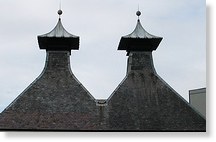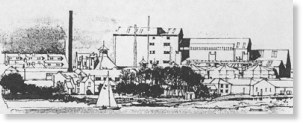| Port
Ellen Single Malt Scotch Whisky
Port Ellen Distillery Port Ellen,
Isle of Islay PA42 7AH Scotland
Viewer's Comments about Port Ellen
 Port
Ellen Distillery was founded by Alexander Ker Mackay, with
the support of the proprietor of Islay, Walter Campbell, shortly
before the Excise Act of 1824 had reduced the duty on spirits
from an exorbitant to a moderate level, to encourage the legal
distillation of whisky. The Act enforced the introduction
of the spirit safe in distilleries, but not before tests had
been made to ensure that it had no harmful effects on the
make. The official experiments were carried out at Port Ellen
in 1824. Port
Ellen Distillery was founded by Alexander Ker Mackay, with
the support of the proprietor of Islay, Walter Campbell, shortly
before the Excise Act of 1824 had reduced the duty on spirits
from an exorbitant to a moderate level, to encourage the legal
distillation of whisky. The Act enforced the introduction
of the spirit safe in distilleries, but not before tests had
been made to ensure that it had no harmful effects on the
make. The official experiments were carried out at Port Ellen
in 1824.
All Islay distilleries were built on the shore-line, because
much of their trade was seaborne. A pier was built in 1826.
The village of Port Ellen grew up round the pier and eventually
overtook Bowmore as the island's port.
Mackay was involved in bankruptcy proceedings within months
of starting up. He was followed, in rapid succession, by three
relatives, none of whom made a success of the business. One
of the problems was finding a steady market for the make.
The family sent another member, John Ramsay, an importer of
sherry and madeira in Glasgow, to put matters right. He gained
the confidence in the laird of Islay and was granted a lease
of the distillery in 1836.
John Ramsay (1814-92) was a man of many interests and above
all an innovator. He became one of the pioneers of the export
trade in Scotch whisky to the United States, inaugurated the
first bi-weekly cargo and passenger service by steamship between
Islay and Glasglow, was chairman of the Glasgow Chamber of
Commerce, was elected Liberal MP for Stirling in 1868 and
for Falkirk from 1874 to 1886, received the freedom of Linlithgow
for parliamentary services and earned the gratitude of Islay
for enlarging and improving the pier at Port Ellen in 1881.
When Ramsay passed away in 1892, he owned all of the parish
of Kildalton and Oa, had built houses at Carnmore and Kildalton
for his own occupation, many minor estate houses, farm houses
and steadings, with miles of stone walls, and had done much
to improve the standard of farming on the island.
The distillery was carried on under the owndership of Mrs.
Ramsay until her death in 1906 when the estate passed to her
son, Captain Iain Ramsay of Kildalton (1875-1959), an authority
on the birds of Islay. From the time of the restrictions on
the whisky industry during the Great War to the introduction
of Prohibition in the USA, the business was struggling to
survive. Captain Ramsay sold the property and assets in 1920
to the Port Ellen Distillery Co. Ltd., owned by James Buchanan
& Co., of London and Glasgow, and John Dewar & Sons
Ltd., of Perth, both of which merged with the Distillers Company
Limited, of Edinburgh, in 1925. The distillery was one of
the many which closed down, some never to re-open, in the
economic depression of 1930.
In that year, all malt whisky distilleries owned by companies
in The Distillers Company Limited were transferred to the
ownership of its subsidiary, Scottish Malt Distillers, Ltd.
Port Ellen Distillery  was
used as a maltings and bonded warehouse for the next thirty
six years. Production however, did not resume until the mid
1960s. was
used as a maltings and bonded warehouse for the next thirty
six years. Production however, did not resume until the mid
1960s.
Her Majesty the Queen visited the Maltings on August 11, 1980.
A presentation bottling of Port Ellen whisky was made to mark
the occasion.
At the time Port Ellen closed in 1983, it was within the Diageo
portfolio. The production buildings were cleared and redeveloped,
however, the maltings are still in operation. A light industrial
park now occupies the site of Port Ellen. Courtesy
of Diageo Scotland |
|
PORT ELLEN 1982 CONNOISSEURS
CHOICE SINGLE MALT SCOTCH WHISKY Colour:
Pale gold.
Undiluted Nose: Peaty and medicinal, cereal
notes and a citrus fruit aroma.
Nose w/ water: Medicinal
(slightly oily), fruits - artificial flavours -
bananas and melons.
Undiluted Palate:
Ashy with birch and salty driftwood flavours. Spicy.
Palate w/ water:
Smoky, more fruit and green leaf flavours. Drying,
spicy note remains.
Body: Balanced.
Finish: Peat smoke
with spicy edge.
Whisky Style: Some would say “the”
Islay Malt - complex yet balanced flavours.
Tasting Notes by Gordon & MacPhail |
|
|
|
|
Port Ellen Whisky Distillery

The Port Ellen Distillery was founded in 1824, closed in 1930
and reopened 36 year later. As part of a programme to ensure
adequate supplies of the distinctive Islay whiskies to meet
the needs of its blending companies, the Distillers Company
Limited decided to bring Port Ellen back into production.
Rebuilding began in the spring of 1966 and was completed on
April 1, 1967. The old distillery had been well designed,
so the shells of some of the original buildings were retained.
Some of the new buildings replaced others where the same part
of the process had been carried on a hundred years earlier.
The new distillery restarted with four stills heated by a
mechanical coal stoker system. They were converted to steam
heating from an oil-fired boiler in 1970. Water for mashing
and distilling is drawn from Leorin Lochs, where SMD had water
rights.
A mechanical drum maltings was built in 1973 to supply the
entire requirements of SMD's three distilleries on Islay.
They had hitherto operated floor maltings on their own sites,
but their combined capacity amounted to only one-third of
the total amount required. The balance had to be imported
from maltings on the mainland.
Port Ellen Maltings had been designed to permit the handling
and processing of barley and malt in bulk. A system of remote
controls, operating from a central panel in the plant house,
governs every movement of barley and malt in and out of storage
and from storage to process. The entire layout of the storage
and conveying systems is illustrated in miniature on the panel,
and sequence interlocks virtually preclude operational mistakes.
Barley for malting was shipped to Port Ellen pier in a motor
coasters designed for this traffic. The cargo, approximately
900 tonnes, was discharged by a suction unit to SMD's transfer
silo on the pier and transferred by road to silos in the Maltings.
In the drum house, barley is germinated in seven drums, each
with a capacity of 48 tonnes. When the barley had germinated,
it was moved to one of three kilns, where it was dried. Each
kiln was fired by both oil and peat. The drying cycled lasted
for 36 hours (about double the time needed in drum maltings
on the mainland). One of the objects of kilning is to cure
the malt by application of peat smoke and ensure the characteristic
flavour associated with Islay whiskies.
The peat was cut locally. Cutting started in March, or as
soon as the weather permitted. The cut peats were piled in
stacks on the peat moss to allow natural drying by sun and
wind. The peat was dry by late summer and ready for transportation
to the storage sheds at the maltings. About 3,000 tonnes or
8,000 cubic metres of peat were used annually.
The Port Ellen Distillery was closed in 1983. The production
buildings were demolished to make way for new development.
The maltings however, are still in operation.
Courtesy of Diageo Scotland |
|

